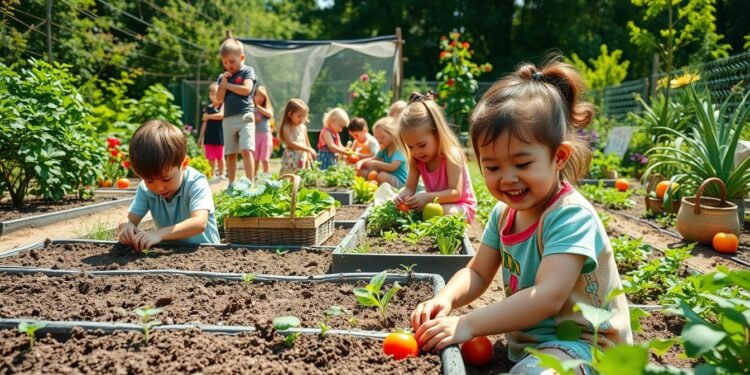Did you know that a simple garden can become a powerful tool for teaching children about nature and where their food comes from? In today’s fast-paced world, finding ways to connect kids to the outdoors while fostering curiosity and creativity is more important than ever.
Whether you have a backyard or just a small balcony, growing vegetables and plants can be a rewarding experience for children of all ages. It’s not just about digging in the dirt—it’s about sparking a lifelong love for learning and exploration.
From observing plant growth to building sunflower houses, these activities blend fun with education. Ready to discover how to make the most of this hands-on adventure? Let’s dive in!
Key Takeaways
- Introduces children to the wonders of nature and food sources.
- Combines outdoor activity with STEM learning opportunities.
- Adaptable for all ages and spaces, including small containers.
- Encourages sensory engagement and creativity.
- Provides practical tips for overcoming common challenges.
Why Gardening with Kids Is a Rewarding Experience
Gardens offer a unique way for children to connect with the world around them. They become outdoor classrooms where kids learn about food sources and environmental care. This hands-on experience fosters curiosity and responsibility in a fun and engaging manner.
One of the greatest benefits is teaching environmental stewardship. Kids see the seed-to-table cycle firsthand, understanding how food grows and why it’s important to care for the earth. Activities like planting and watering also boost physical health, keeping them active and engaged.
Gardening helps develop problem-solving skills. When crops fail or pests appear, children learn to troubleshoot and adapt. These challenges teach resilience and critical thinking in a practical way.
Shared tasks, like harvesting strawberries or building compost bins, create bonding opportunities. Working together strengthens relationships and builds teamwork. Plus, kids feel a sense of pride when they eat homegrown produce like rainbow carrots or cherry tomatoes.
This rewarding activity instills confidence and encourages healthier eating habits. It’s a wonderful way to connect kids with nature while teaching life lessons like delayed gratification and the joy of hard work.
How to Get Started: Setting Up a Kid-Friendly Garden
Starting a kid-friendly garden is easier than you think. With a few simple steps, you can create a space where children can explore, learn, and grow. The key is to make it accessible, engaging, and safe for little hands.
Choosing the Right Space
Begin by selecting the right area for your garden. Raised beds or containers are ideal for kids. They prevent trampling and make it easier for children to reach the plants. If you’re working with limited space, even a small balcony or patio can work.
Define play and growing areas with mulch pathways or stepping stones. This helps kids understand where they can walk and where the plants are growing. Assigning personalized containers or small plots also gives children a sense of ownership.
Selecting Child-Sized Tools
Equip your little gardeners with durable, lightweight tools. Mini rakes, shovels, and watering cans from brands like Gardena are perfect for small hands. These tools make it easier for kids to dig, plant, and water without frustration.
Let kids decorate plant tags with drawings or labels. This is especially helpful for non-readers who can identify plants like radishes or carrots by their sketches. It’s a fun way to personalize their garden space.
Avoid chemicals and opt for organic pest control methods. Releasing ladybugs or using natural sprays keeps the garden safe for kids and the environment. With the right setup, your garden will be a place of joy and discovery for children.
Best Plants for Gardening with Kids
Choosing the right plants can make all the difference in a child’s outdoor adventure. Opt for varieties that are easy to grow, quick to mature, and engaging for little hands. This ensures kids stay excited and involved throughout the process.
Fast-Growing Vegetables
Kids love seeing quick results, so start with fast-growing vegetables. Radishes are a great choice, ready to harvest in just 3-4 weeks. Green beans and cherry tomatoes are also foolproof options for beginners.
Large seeds like beans and sunflowers are perfect for small hands. They’re easy to plant and handle, making the process less frustrating. Sugar snap peas add a crunchy texture, while carrots bring a fun surprise when pulled from the ground.
Colorful Flowers
Bright and cheerful flowers add a splash of color to any garden. Sunflowers are a favorite, growing tall and providing a natural play structure. Pumpkins are another fun option, especially when kids carve them in the fall.
Include sensory plants like fragrant basil or fuzzy lamb’s ear to engage kids’ senses. Strawberries in hanging baskets are a hit, offering sweet rewards and requiring minimal space. These choices keep the garden vibrant and exciting.
Combining fast-growing vegetables and colorful flowers creates a dynamic space. It’s a perfect blend of learning, play, and discovery for young gardeners.
Fun Gardening Projects for Kids
Transform your outdoor space into a playground of discovery with these fun projects. These activities are designed to engage young minds while teaching them about nature and creativity. From building structures to personalizing plants, there’s something for every child to enjoy.
Building a Green Bean Teepee
Create a magical hideaway with a green bean teepee. Use bamboo poles and twine to construct a simple frame. Space the poles evenly and tie them at the top to form a cone shape.
Plant green bean seeds around the base and train the vines to grow upward. In just a few weeks, the teepee will be covered in lush greenery, providing a shady spot for kids to play and explore.
Creating a Sunflower House
Turn sunflowers into a living playhouse. Plant sunflower seeds in a square shape, spacing them about 6 inches apart. Leave an opening for a doorway.
As the sunflowers grow, they’ll form tall, natural walls. Kids can enjoy their own secret garden inside. Add a few chairs or a small table for extra fun.
Other creative ideas include carving names into young pumpkins or zucchini. Watch as the names grow along with the plants. Craft DIY birdhouses or painted rock markers to personalize the space further. These projects make the garden a place of wonder and imagination.
Gardening with Kids: Tips for Success
Helping children thrive in the garden requires a thoughtful approach. By keeping tasks simple and encouraging independence, you can create a positive and engaging experience. Start small to avoid overwhelming them and build their confidence over time.
Keeping It Simple
Begin with age-appropriate tasks. Toddlers can handle watering, while teens might enjoy composting. Avoid large plots; a small container or raised bed is a great way to start. Use a “little and often” approach—15-minute daily sessions keep kids interested without burnout.
Turn chores into games. For example, challenge them to pull 10 weeds the fastest. This makes the work fun and keeps them engaged. Celebrate mistakes, like overwatered seedlings, as learning moments. These experiences teach resilience and problem-solving.
Encouraging Independence
Let kids choose 2-3 crops to grow. This cultivates autonomy and keeps them invested in the process. Assign responsibilities gradually, like tracking plant growth in a journal. These small tasks build confidence and a sense of accomplishment.
Introduce tools and techniques step by step. Mini rakes and watering cans are perfect for small hands. Over time, they’ll develop skills and take pride in their work. By fostering independence, you’re helping them grow alongside the garden.
How to Plant a School Garden
A school garden is a fantastic way to blend education and hands-on learning for children. It’s not just about growing vegetables—it’s about teaching teamwork, nutrition, and environmental care. Whether you have a large outdoor space or just a few containers, starting a school garden is achievable and rewarding.
Begin by partnering with local nurseries for seed donations or soil contributions. This reduces costs and builds community connections. Assign each class to a themed bed, like a pizza garden with tomatoes, basil, and peppers. This approach makes the project fun and relatable for kids.
Integrate STEM lessons by measuring soil pH levels or tracking plant growth rates. These activities turn the garden into an outdoor classroom. Host harvest festivals where students can taste roasted veggies or herb-infused drinks. Celebrating their hard work keeps them motivated and engaged.
For urban schools, container gardens are a great solution. Try growing potatoes in bags or herbs in window boxes. These options are space-efficient and easy to manage. Apply for grants like USDA’s Farm to School program to secure funding for your project.
A school garden connects children to nature while teaching valuable life skills. It’s a hands-on way to inspire curiosity, creativity, and a love for the environment.
Gardening Activities for Older Kids
Older children can take their outdoor adventures to the next level with creative gardening activities. These projects not only deepen their connection to nature but also teach valuable skills like planning, experimentation, and problem-solving.
Planning a Theme Garden
Theme gardens are a fantastic way to engage older kids. For example, a “rainbow garden” can include purple carrots, yellow tomatoes, and red lettuce. This colorful approach makes the experience fun and visually appealing.
Another idea is a salsa garden, featuring tomatoes, peppers, and cilantro. Teens can design layouts using graph paper and seed catalogs, giving them a sense of ownership and creativity. These themed spaces encourage exploration and even help picky eaters try new foods.
Experimenting with Different Plants
Older kids often enjoy experimenting with unique plant varieties. Heirloom options like glass gem corn or dragon tongue beans add excitement to the garden. These unusual plants spark curiosity and teach about biodiversity.
For a hands-on science project, challenge teens to grow hydroponic herbs or compost with worms. They can use garden data for science fairs, such as studying the effect of music on plant growth. Partnering with local chefs to cook harvest meals, like stir-fries or herb pizzas, adds a delicious reward to their hard work.
Harvesting and Enjoying the Fruits of Your Labor
Harvesting is one of the most exciting parts of growing your own food. It’s a chance to see the results of hard work and enjoy fresh, homegrown produce. For children, this stage is especially rewarding as they get to taste the fruit of their efforts.
Teaching Kids About Harvesting
Start by showing kids how to harvest gently. Teach them to twist tomatoes off the vine or use scissors for leafy greens like kale. These techniques protect the plants and ensure a healthy yield.
Let children shell peas or husk corn for immediate snacks. These hands-on activities make harvesting fun and engaging. Host a “pick-and-eat” day with cherry tomatoes, snap peas, and strawberries to celebrate their hard work.
Cooking with Garden Produce
Turn your harvest into delicious meals. Bake zucchini bread or blend fresh pesto using homegrown basil. These recipes are simple and let kids enjoy the flavors of their garden.
Preserve excess produce by freezing green vegetables or drying apple slices. These methods extend the life of your harvest and teach valuable skills. Make herb-infused oils or loofah scrubbers for creative, practical uses.
Donate surplus veggies to local food banks. This teaches children about community sharing and the importance of helping others. Harvesting and cooking together create lasting memories and a deeper connection to nature.
Gardening with Kids: Overcoming Challenges
Facing challenges in the garden can be a valuable learning experience for children. Not every plant thrives, but every setback teaches a lesson. With the right approach, you can turn obstacles into opportunities for growth and discovery.
Dealing with Failed Crops
Failed crops are a natural part of gardening. Instead of frustration, frame these moments as learning opportunities. For example, if birds eat your berries, introduce bird netting as a solution. This teaches problem-solving and resilience.
Pest infestations, like aphids, can also be educational. Introduce ladybugs to control them, turning the issue into a biology lesson. Keep a garden diary to track what works and what doesn’t. This helps kids understand patterns and improve over time.
Managing Mess and Dirt
Mess and dirt are inevitable, but they don’t have to be overwhelming. Use mulch to minimize mud and designate specific play zones. This keeps the growing areas protected while allowing kids to explore freely.
Set up a “mud station” with washable outdoor rugs for easy cleanup. Pre-soak seeds to improve germination rates, which is especially helpful for impatient growers. These small tips make the experience smoother and more enjoyable for everyone.
By embracing challenges, you teach children that setbacks are part of the process. This mindset fosters resilience and a deeper connection to nature.
Conclusion
Cultivating a love for nature starts with small, meaningful steps. Gardening with kids is more than just planting seeds—it’s a way to spark curiosity, build resilience, and create lasting memories. Whether you’re growing tomatoes in a pot or building a sunflower house, every experience teaches valuable lessons.
Share your successes on social media using hashtags like #GrowingWithKids. For more tips, check out Angela Judd’s container gardening book or the Almanac planting guides. Remember, even a failed garden offers opportunities to learn and grow.
Ready to start? Grab a trowel and let’s grow something amazing together!
FAQ
Why is gardening a rewarding experience for children?
It teaches responsibility, patience, and the value of hard work. Kids also learn about nature and where food comes from while having fun outdoors.
How do I choose the right space for a kid-friendly garden?
Pick a sunny spot with good soil that’s easy for kids to access. Make sure it’s safe and free from hazards like sharp tools or chemicals.
What are the best plants for children to grow?
Fast-growing vegetables like radishes and beans, or colorful flowers like sunflowers and marigolds, are great choices for young gardeners.
What are some fun projects to try with kids in the garden?
Building a green bean teepee or creating a sunflower house are creative and engaging activities that make the experience memorable.
How can I encourage independence while gardening with kids?
Let them take charge of simple tasks like watering or planting seeds. Provide child-sized tools to make the process easier and more enjoyable.
What should I do if a crop fails?
Use it as a learning opportunity. Discuss what might have gone wrong and try again with a different plant or approach.
How can I manage mess and dirt when gardening with kids?
Set up a designated area for messy activities and keep cleaning supplies nearby. Embrace the dirt as part of the fun!
What are some gardening activities for older kids?
Planning a theme garden or experimenting with different plants can challenge older children and spark their creativity.
How can I teach kids about harvesting?
Show them how to pick ripe produce and explain the importance of timing. Let them taste the fruits of their labor to make it rewarding.
Can cooking with garden produce be part of the experience?
Absolutely! Involve kids in preparing meals with the vegetables and herbs they’ve grown. It’s a great way to connect gardening to everyday life.









